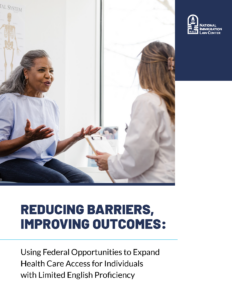Special Reports
Immigrants at the Border of Equity & Opportunity Eliminating Barriers for Low-income
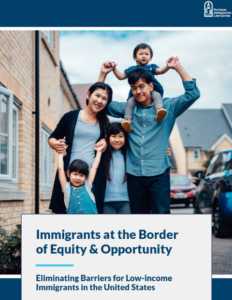 The lived experiences of immigrants in the United States do not begin and end with their interaction with enforcement and deportation regimes, despite the dominance of these issues in political rhetoric. Too often, policy discussions are missing the perspectives of immigrants themselves. As a result, policymaking fails to address the complex and layered issues affecting immigrants’ lives. Low-income immigrants face numerous disparities and inequities compared to native-born individuals and immigrants more broadly, but their voices are rarely centered in policy debates. To address this gap, in early 2023 the National Immigration Law Center (NILC) traveled to seven different cities across the U.S. to conduct focus groups and administer surveys to immigrants with low incomes and service providers working with those communities. The focus groups included both lawfully present and undocumented participants from Africa, China, Haiti, Korea, and Latin America living in California, Florida, Nevada, New York, Tennessee, and Texas.
The lived experiences of immigrants in the United States do not begin and end with their interaction with enforcement and deportation regimes, despite the dominance of these issues in political rhetoric. Too often, policy discussions are missing the perspectives of immigrants themselves. As a result, policymaking fails to address the complex and layered issues affecting immigrants’ lives. Low-income immigrants face numerous disparities and inequities compared to native-born individuals and immigrants more broadly, but their voices are rarely centered in policy debates. To address this gap, in early 2023 the National Immigration Law Center (NILC) traveled to seven different cities across the U.S. to conduct focus groups and administer surveys to immigrants with low incomes and service providers working with those communities. The focus groups included both lawfully present and undocumented participants from Africa, China, Haiti, Korea, and Latin America living in California, Florida, Nevada, New York, Tennessee, and Texas.
Published by NILC, March 2024
States Continue to Invest in the Health and Well-Being of Immigrants: Highlights From 2023
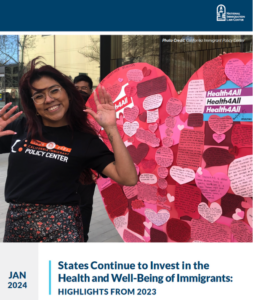 State immigrant rights movements continued to gain ground in 2023. “Health Care for All” campaigns achieved significant victories, while legislatures across the political spectrum expanded access to care for immigrant children and/or pregnant people. California, Colorado, Connecticut, Illinois, Minnesota, Nevada, Oregon, Utah, Washington, and the District of Columbia enacted several immigrant inclusive measures. And Delaware, Georgia, Hawaii, Indiana, Maine, Maryland, Massachusetts, Michigan, Missouri, Nebraska, New Hampshire, New Jersey, New Mexico, New York, North Dakota, Rhode Island, Vermont, and Virginia also adopted pro-immigrant laws or policies. As detailed in this report, states improved access to driver’s licenses, higher education, professional licenses, childcare, tax credits, and nutrition assistance, protected workers’ rights, strengthened consumer privacy, and invested in access to counsel for immigrants. With a new Democratic trifecta, advocates in Minnesota secured a series of laws that had been championed for many years.
State immigrant rights movements continued to gain ground in 2023. “Health Care for All” campaigns achieved significant victories, while legislatures across the political spectrum expanded access to care for immigrant children and/or pregnant people. California, Colorado, Connecticut, Illinois, Minnesota, Nevada, Oregon, Utah, Washington, and the District of Columbia enacted several immigrant inclusive measures. And Delaware, Georgia, Hawaii, Indiana, Maine, Maryland, Massachusetts, Michigan, Missouri, Nebraska, New Hampshire, New Jersey, New Mexico, New York, North Dakota, Rhode Island, Vermont, and Virginia also adopted pro-immigrant laws or policies. As detailed in this report, states improved access to driver’s licenses, higher education, professional licenses, childcare, tax credits, and nutrition assistance, protected workers’ rights, strengthened consumer privacy, and invested in access to counsel for immigrants. With a new Democratic trifecta, advocates in Minnesota secured a series of laws that had been championed for many years.
Published by NILC, January 2024
Building Worker Power Through Deferred Action: A Report on the First Year
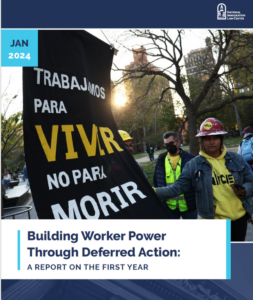 For decades, immigrant workers have faced poor working conditions and unfair wages because their employers could retaliate against them based on their immigration status.
For decades, immigrant workers have faced poor working conditions and unfair wages because their employers could retaliate against them based on their immigration status.
The lack of meaningful protections has not only had an effect on immigrant workers coming forward to report labor violations but has also stymied labor agencies in investigating the abuses. Yet over the years, many brave workers have come forward despite the risks to assert their rights and—in partnership with advocates—change government policy.
On January 13, 2023, DHS issued streamlined guidance that allows workers involved in labor disputes to request ”deferred action“ on deportation and obtain work authorization for a potentially renewable period of two years.
The purpose of this report is to commemorate the one-year anniversary of this guidance by celebrating its impact, discussing the outcomes of NILC’s campaign around this guidance, and making recommendations for improving and expanding the effective implementation of the guidance.
Published by NILC, January 2024
On The Path Toward Health for All Series
 Every person in this country should be able to get healthcare when they need it, regardless of the color of their skin, how much money they have, or where they were born. It’s really that simple. This moral principle, coupled with clear evidence that the expansion of health insurance leads to higher productivity and economic growth, forms the basis of our commitment. This series offers policy and campaign insights developed through our collaboration with advocates and activists in the states. We hope that this momentum and insight can guide the next stage in the fight for Health for All, particularly for immigrants.
Every person in this country should be able to get healthcare when they need it, regardless of the color of their skin, how much money they have, or where they were born. It’s really that simple. This moral principle, coupled with clear evidence that the expansion of health insurance leads to higher productivity and economic growth, forms the basis of our commitment. This series offers policy and campaign insights developed through our collaboration with advocates and activists in the states. We hope that this momentum and insight can guide the next stage in the fight for Health for All, particularly for immigrants.
Published by NILC, December 2023
Expanding Health Care Access for Individuals with Limited English Proficiency
The United States’ health care system consistently fails people whose primary language is not English, frequently known as individuals with limited English proficiency (LEP).
These breakdowns result in increases in both unnecessary care due to misdiagnoses and poor health outcomes.
This paper describes the policy interventions that Congress and federal agencies can take to address these health disparities.
Published by NILC, July 2023; 14 pp
DACA Recipients’ Access to Health Care: 2023 Report
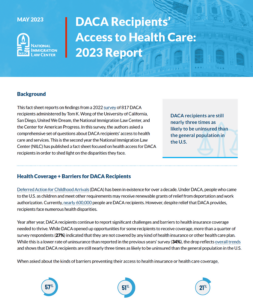 This fact sheet reports on findings from a 2022 survey of 817 DACA recipients administered by Tom K. Wong of the University of California, San Diego, United We Dream, the National Immigration Law Center, and the Center for American Progress. In this survey, the authors asked a comprehensive set of questions about DACA recipients’ access to health care and services. This is the second year the National Immigration Law Center (NILC) has published a fact sheet focused on health access for DACA recipients in order to shed light on the disparities they face.
This fact sheet reports on findings from a 2022 survey of 817 DACA recipients administered by Tom K. Wong of the University of California, San Diego, United We Dream, the National Immigration Law Center, and the Center for American Progress. In this survey, the authors asked a comprehensive set of questions about DACA recipients’ access to health care and services. This is the second year the National Immigration Law Center (NILC) has published a fact sheet focused on health access for DACA recipients in order to shed light on the disparities they face.
Published by NILC, May 2023; 4 pp
A Decade of State Immigrant Rights Victories: Moving Toward Health Care and Economic Justice for All
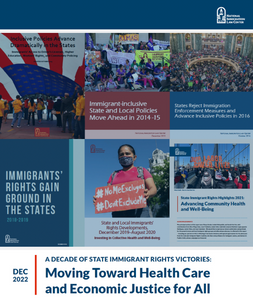 This report highlights some of the immigrant rights victories achieved in 2022 and provides an overview of current state policies on access to health care, economic support, and other opportunities for students and workers who are immigrants.
This report highlights some of the immigrant rights victories achieved in 2022 and provides an overview of current state policies on access to health care, economic support, and other opportunities for students and workers who are immigrants.
Published by NILC, December 2022; 25 pp.
Tracking DACA Recipients’ Access to Health Care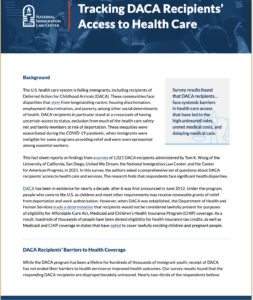
The National Immigration Law Center has carefully researched how the U.S. health care system is failing immigrants, including recipients of Deferred Action for Childhood Arrivals (DACA).
Published by NILC, July 2022; 3 pp.
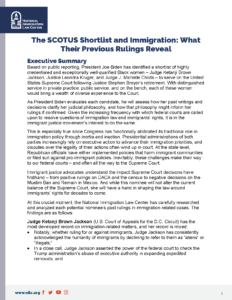 The SCOTUS Shortlist and Immigration: What Their Previous Rulings Reveal
The SCOTUS Shortlist and Immigration: What Their Previous Rulings Reveal
The National Immigration Law Center has carefully researched and analyzed each of President Biden’s potential Supreme Court nominee’s past rulings in immigration-related cases to assess how their past writings and decisions might inform their rulings if confirmed.
Published by NILC, February 2022; 7 pp.
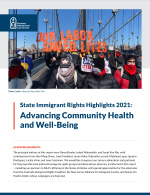 State Immigrant Rights Highlights 2021: Advancing Community Health and Well-Being
State Immigrant Rights Highlights 2021: Advancing Community Health and Well-Being
This report highlights the immigrant inclusive laws enacted in 2021, as well as some pending bills and campaigns. During this time, states adopted policies improving access to health care, higher education, and professional licenses for immigrants; protecting the rights of workers and tenants; investing in access to counsel; strengthening driver and consumer privacy; and limiting local entanglement in federal immigration enforcement efforts.
As Congress considers options for providing a pathway to permanent status or temporary relief to millions of immigrants in the U.S., states and localities have taken significant action to improve the lives of their community members, regardless of their immigration status. In response to effective local organizing, almost half the states adopted immigrant-inclusive laws and policies in 2021.
Published by NILC, January 2022; 26 pp.
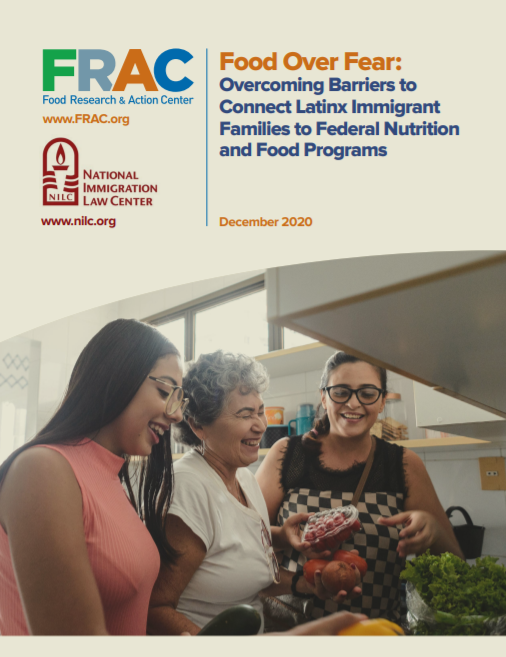 Food Over Fear: Overcoming Barriers to Connect Latinx Immigrant Families to Federal Nutrition and Food Programs
Food Over Fear: Overcoming Barriers to Connect Latinx Immigrant Families to Federal Nutrition and Food Programs
This report sheds light on why many immigrant families are forgoing vital assistance from federal nutrition and food programs and lifts up recommendations aimed at ensuring that all families and individuals, regardless of immigration status, are nourished and healthy.
While the findings of this report are informed by a series of focus groups conducted from November 2019 to January 2020 (prior to the onset of COVID-19), the need to connect immigrant families to nutrition programs is arguably of even greater importance given how COVID-19 is fueling unprecedented food insecurity and ravaging communities of color and immigrant communities at disproportionately high rates due to unique barriers faced by families that include noncitizens.
Published by NILC and Food Research and Action Center (FRAC), December 2020; 24 pp.
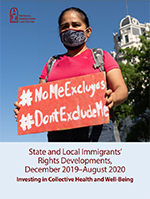 State and Local Immigrants’ Rights Developments, December 2019–August 2020: Investing in Collective Health and Well-Being
State and Local Immigrants’ Rights Developments, December 2019–August 2020: Investing in Collective Health and Well-Being
The COVID-19 pandemic’s disproportionate impact on immigrants and on Black, Indigenous, and low-income communities of color has forced the United States to confront longstanding disparities in access to care and economic support, as well as the harmful effects of policing and carceral systems. Rather than addressing these issues, the federal administration’s policies have thwarted efforts to protect public health, leaving states and localities to fend for themselves.
This report highlights the immigrant-inclusive state laws and policies adopted from December 2019 through August 2020, including state and local efforts to provide relief to immigrant residents harmed by the COVID crisis and measures that limit their involvement in federal immigration enforcement and detention.
Published by NILC, September 2020; 24 pp.
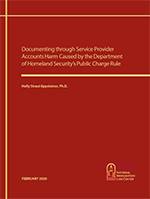 Documenting through Service Provider Accounts Harm Caused by the Department of Homeland Security’s Public Charge Rule
Documenting through Service Provider Accounts Harm Caused by the Department of Homeland Security’s Public Charge Rule
Drawing on interviews with 24 service providers working with immigrant communities in 11 states, the findings detailed in this report contribute to the body of accounts that seek to document the harm that stems from the public charge rule that was published by the Trump administration’s U.S. Department of Homeland Security in August 2019.
The interviews were conducted between the time the rule was published as a proposed rule in October 2018 until just after it was finalized. They reveal the range of individuals and families being chilled from participation in benefits and services and the conditions under which they feel at risk for doing so. These findings also identify implications for the service providers who work in immigrant communities as they seek to inform their clients and patients about the rule, overcome misinformation, and cope with burdens associated with chilling effects.
Published by NILC, February 2020; 25 pp.
 Immigrants’ Rights Gain Ground in the States: 2018-2019
Immigrants’ Rights Gain Ground in the States: 2018-2019
While the U.S. president took multiple actions during 2018 and 2019 to restrict immigration and make life more difficult for immigrants in the United States, states overwhelmingly rejected harsh measures and instead advanced policies that improve the lives of immigrants in their communities across the country. Following the 2018 elections, and in response to the administration’s escalating threats, immigrants’ rights organizing advanced substantially in the states.
Advocates not only defeated most anti-immigrant proposals and secured policies limiting state and local entanglement in immigration enforcement, but they gained significant ground in campaigns to expand access to higher education, professional licenses, driver’s licenses, health care, and legal representation for immigrants. Collectively, advocates moved states to adopt major criminal justice reforms and measures to protect the privacy of both citizens and non-U.S. citizens.
This report highlights some of the victories won by immigrants’ rights advocates, organizers, and allies in the states during 2018 and 2019.
Published by NILC, December 2019; 40 pp.
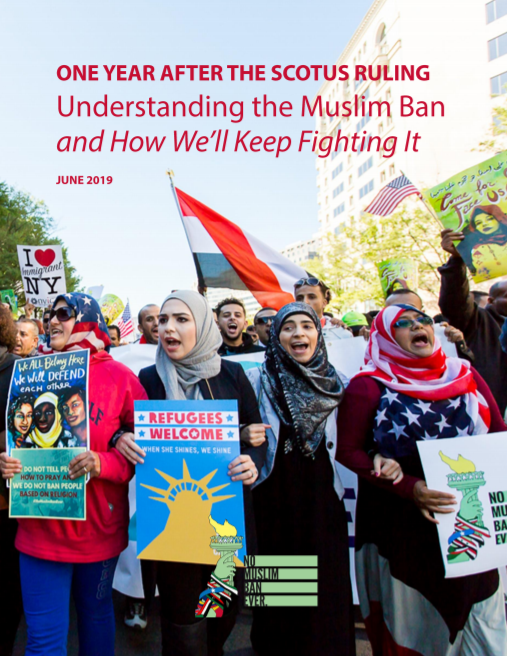 One Year After the SCOTUS Ruling: Understanding the Muslim Ban and How We’ll Keep Fighting It
One Year After the SCOTUS Ruling: Understanding the Muslim Ban and How We’ll Keep Fighting It
On January 27, 2017, President Trump signed his first Muslim ban, immediately impacting thousands of people around the world. This executive order banned entry into the United States for 90 days of nationals from seven Muslim-majority countries, banned the entry of all refugees for 120 days, and indefinitely banned the entry of all Syrian refugees. It was the first of many horrific discriminatory policies the Trump administration has implemented.
Although the Supreme Court eventually allowed the third version of Trump’s Muslim ban to go into effect, the fight is not over. The No Muslim Ban Ever Campaign is supporting efforts in Congress and in the courts to (1) repeal the ban and (2) demand transparency and accountability for the ban’s waiver process, with the aim of exposing it as cover for the ban’s clearly discriminatory intent. While transparency and accountability with respect to the waiver process is critical, the campaign remains ultimately dedicated to making sure that Congress repeals the ban and prevents future efforts like it.
Published by NILC and No Muslim Ban Ever, June 2019; 42 pp.
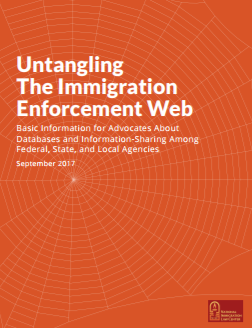 Untangling the Immigration Enforcement Web: Basic Information for Advocates about Databases and Information-Sharing Among Federal, State, and Local Agencies
Untangling the Immigration Enforcement Web: Basic Information for Advocates about Databases and Information-Sharing Among Federal, State, and Local Agencies
Immigrants are caught in a complex and opaque web of databases, related systems, and information-sharing mechanisms that facilitate immigration enforcement and erect barriers to their full participation in economic and social life in the United States. These databases, systems, and mechanisms often depend on the entanglement of state and local law enforcement or licensing agencies with federal immigration and law enforcement agencies.
We hope that the following questions and answers will give immigrants and their advocates a better understanding of (1) how the exchange of data among agencies at different levels of government occurs currently, (2) how to evaluate the potential immigration-related risks and benefits of interacting with federal and state authorities, and (3) how to forge strategies and measures that will protect immigrants more effectively.
Published by NILC, September 2017; 48 pp.
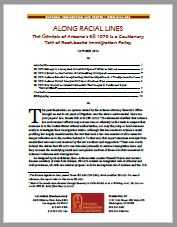 Along Racial Lines: The Genesis of Arizona’s SB 1070 Is a Cautionary Tale of Race-based Immigration Policy
Along Racial Lines: The Genesis of Arizona’s SB 1070 Is a Cautionary Tale of Race-based Immigration Policy
For the authors and supporters of Arizona’s most notorious anti-immigrant law, SB 1070, the existence of the United States as a nation was being threatened by unauthorized immigration. Specifically, this threat was understood to come from immigrants entering the U.S. from Mexico. Their argument claimed that the nation could be saved from this threat only through the strict and punitive enforcement of the country’s immigration laws, even by way of flagrant racial profiling. Using the words of the very individuals who authored SB 1070—and of those who share that worldview—this report unmasks the underlying racism that motivated such an egregious law.
The civil rights groups that sued to try to prevent SB 1070 from being enforced have settled their lawsuit with Arizona authorities, just as the nation is embroiled in a public conversation that feels eerily reminiscent of private musings among SB 1070’s most ardent supporters. The email excerpts in this report provide just a few examples of why Americans should be alarmed by the motives behind Arizona’s law and laws cast from its mold.
Published by NILC, October 2016; 10 pp.
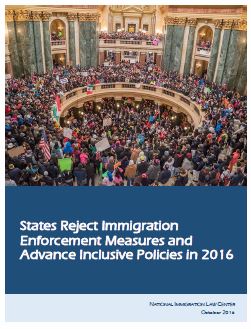 States Reject Immigration Enforcement Measures and Advance Inclusive Policies in 2016
States Reject Immigration Enforcement Measures and Advance Inclusive Policies in 2016
2016 marked a departure from earlier years, with a high-pitched partisan battle between state elected officials and President Barack Obama on immigration and refugee policy, as well as backlash against localities that had chosen to limit their entanglement with immigration enforcement efforts. Despite significant challenges, the groundwork built by immigrant rights advocates and allies proved effective in defeating virtually all the restrictive bills that were introduced. Thanks to strategic organizing by advocates, directly affected communities, faith-based groups and businesses, and to the testimony of municipal and law enforcement leaders, almost all of the anti-immigrant proposals died.
Published by NILC, October 2016; 12 pp.
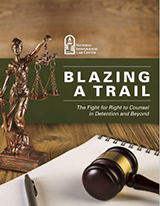 Blazing a Trail: The Fight for Right to Counsel in Detention and Beyond
Blazing a Trail: The Fight for Right to Counsel in Detention and Beyond
The federal government has long interpreted the immigration laws to mean that immigrants have a right to be represented by counsel in their deportation proceedings, but not at government expense. Making the right to counsel a reality is an imperative for all immigrants in removal proceedings, but the situation is even more critical for detained immigrants. As this report shows, the very circumstances of detention make that right a legal fiction for almost all detained immigrants. Mounting empirical data show that having a lawyer to help navigate the complex maze of the immigration detention and court systems makes a profound difference in a person’s ability to gain release from detention, challenge the government’s grounds for seeking their deportation, and present and win a defense that allows the person to remain in the U.S.
Innovative projects in New York and New Jersey have begun to provide what we are calling in this report “universal representation,” i.e., representation to any detained immigrant within the jurisdiction of a particular immigration court who does not have a private lawyer and who meets certain income requirements. Inspired by these examples, other localities across the country are examining how they can develop similar programs.
Published by NILC, March 2016; 48 pp.
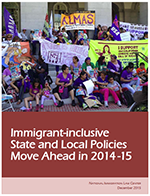 Immigrant-inclusive State and Local Policies Move Ahead in 2014–15
Immigrant-inclusive State and Local Policies Move Ahead in 2014–15
After a landmark year in 2013, the immigrant-inclusive state measures enacted that year were implemented and gained ground in 2014–15. States continued to expand access to higher education, driver’s licenses, health care, and professional licenses for eligible immigrants, regardless of their immigration status. Cities and counties adopted policies aimed at disentangling local law enforcement from federal immigration enforcement and explored providing access to legal counsel, health care, and municipal identification documents to their residents. State and local governments established offices charged with integrating immigrants and invested in assistance for people seeking U.S. citizenship or other immigration relief. Although a few restrictive measures passed—and though some serious threats are ongoing—immigrants’ rights advocates and allies defeated virtually all of the significant anti-immigrant proposals filed in the past two years.
Published by NILC, December 2015; 30 pp.
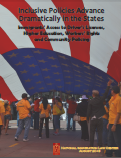 Inclusive Policies Advance Dramatically in the States: Immigrants’ Access to Drivers’ Licenses, Higher Education, Workers’ Rights, and Community Policing
Inclusive Policies Advance Dramatically in the States: Immigrants’ Access to Drivers’ Licenses, Higher Education, Workers’ Rights, and Community Policing
As Congress debated federal immigration reform this year, states led the way by adopting policies designed to integrate immigrants more fully into their communities. In the wake of the 2012 elections, with Latino and Asian voters participating in record numbers, the 2013 state legislative sessions witnessed a significant increase in pro-immigrant activity. Issues that had been dormant or had moved in a restrictive direction for years, such as expanding access to driver’s licenses, gained considerable traction, along with measures improving access to education and workers’ rights for immigrants.
Published by NILC. First published August 2013; updated October 2013; 21 pp.
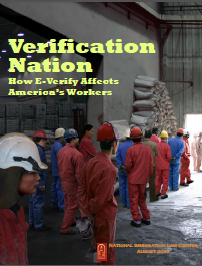 Verification Nation: How E-Verify Affects America’s Workers
Verification Nation: How E-Verify Affects America’s Workers
As part of the current national dialogue about reforming our country’s immigration laws, legislators in both the Senate and the House of Representatives have proposed a national mandate to require all employers to use E-Verify—an electronic employment eligibility verification system—to check their workers’ eligibility to be employed in the United States. In the midst of these discussions, U.S. Citizenship and Immigration Services released to the public a study narrowly focused on the E-Verify program’s accuracy rates. In this report, we analyze the findings of the USCIS-commissioned study and examine, more broadly, the adverse impacts on workers that would result from a national E-Verify mandate.
Published by NILC, August 2013; revised November 2013; 19 pp.
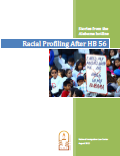 Racial Profiling After HB 56: Stories from the Alabama Hotline
Racial Profiling After HB 56: Stories from the Alabama Hotline
Incidents reported by callers to the hotline reveal three dangerous trends: that the enactment of HB 56 has created a damaging environment of racial profiling by law enforcement officials; that the law’s provisions constitute state-sanctioned discrimination that, in turn, encourages private citizens to discriminate against and abuse people they suspect may be “foreign”; and that the provision requiring Alabama school officials to determine the immigration status of enrolled students (or that of their parents) has discouraged attendance and encouraged discrimination based on students’ appearance and perceived ethnicity.
Because the federal district court in Alabama declined to enjoin provisions in HB 56 that are similar to the “show-me-your-papers” provision of Arizona’s SB 1070, what began to happen in Alabama last fall provides a clear and deeply troubling preview of what we’re likely to see soon in Arizona, as well as in any other states that enact or enforce SB 1070 or HB 56 copycats.
Published by NILC, August 2012, 11 pp.
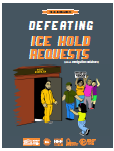 The All-in-One Guide to Defeating ICE Hold Requests (aka Immigration Detainers)
The All-in-One Guide to Defeating ICE Hold Requests (aka Immigration Detainers)
This toolkit is designed to help communities prevent deportations by keeping local police separate from immigration enforcement. The essential link between police and U.S. Immigration and Customs Enforcment (ICE) is the ICE hold request, also known as an immigration detainer. On the basis of ICE hold requests, state and local police hold people in jail longer in order to hand them over to ICE.
Even if federal enforcement initiatives such as Secure Communities, 287(g), and the Criminal Alien Program continue to operate, they are only as effective as ICE hold requests allow them to be. Several communities have succeeded in enacting policies to stop submitting to ICE hold requests, and this toolkit is designed to help other communities establish similar policies.
Published by Washington Defender Association, Immigrant Legal Resource Center, National Immigration Project of the National Lawyers Guild, National Immigration Law Center, and Immigrant Defense Project, 2012, 42 pp.
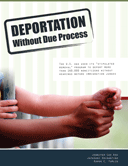 Deportation Without Due Process: The U.S. Has Used Its “Stipulated Removal” Program to Deport More Than 160,000 Noncitizens Without Hearings Before Immigration Judges
Deportation Without Due Process: The U.S. Has Used Its “Stipulated Removal” Program to Deport More Than 160,000 Noncitizens Without Hearings Before Immigration Judges
Using a little-known government program, the U.S. Dept. of Homeland Security has pushed nearly 160,000 immigrants — many with deep ties to the United States — through an expedited deportation process, sometimes without adequately informing them of their right to a day in court, according to a new analysis of thousands of pages of released government documents.
The report, written by attorneys and law professors at Stanford Law School, NILC, and Western State University College of Law, determined that DHS agents administering the program provided legally inaccurate portrayals of the opportunities to remain in the U.S. in order to boost deportation numbers, even though judges and others involved in the program voiced their concerns about how the program short-circuited individuals’ rights.
Published by NILC, Western State Immigration Clinic, & Stanford Law School Immigrants’ Rights Clinic, Sept. 2011, 30 pp.
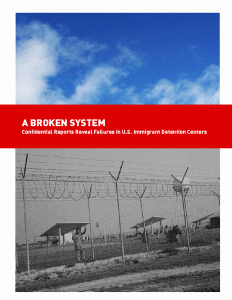 A Broken System: Confidential Reports Reveal Failures in U.S. Immigrant Detention Centers
A Broken System: Confidential Reports Reveal Failures in U.S. Immigrant Detention Centers
This report presents the first-ever system-wide look at the federal government’s compliance with its own standards regulating immigrant detention facilities, a view based on previously unreleased first-hand reports of monitoring inspections. The results reveal substantial and pervasive violations of the government’s minimum standards for conditions at such facilities.
As a result, over 320,000 immigrants locked up each year not only face tremendous obstacles to challenging wrongful detention or winning their immigration cases, but the conditions in which these civil detainees are held often are as bad as or worse than those faced by imprisoned criminals.
Published by NILC, July 2009; 170 pp.






